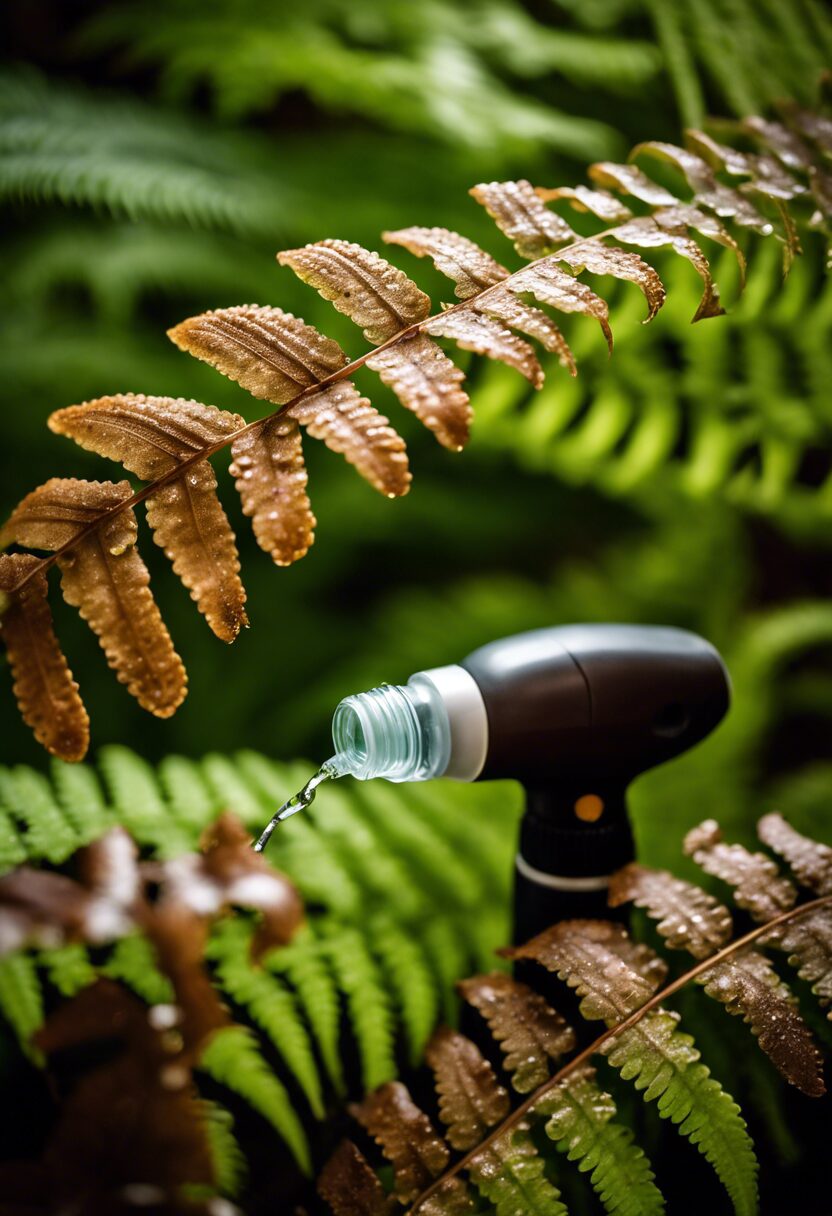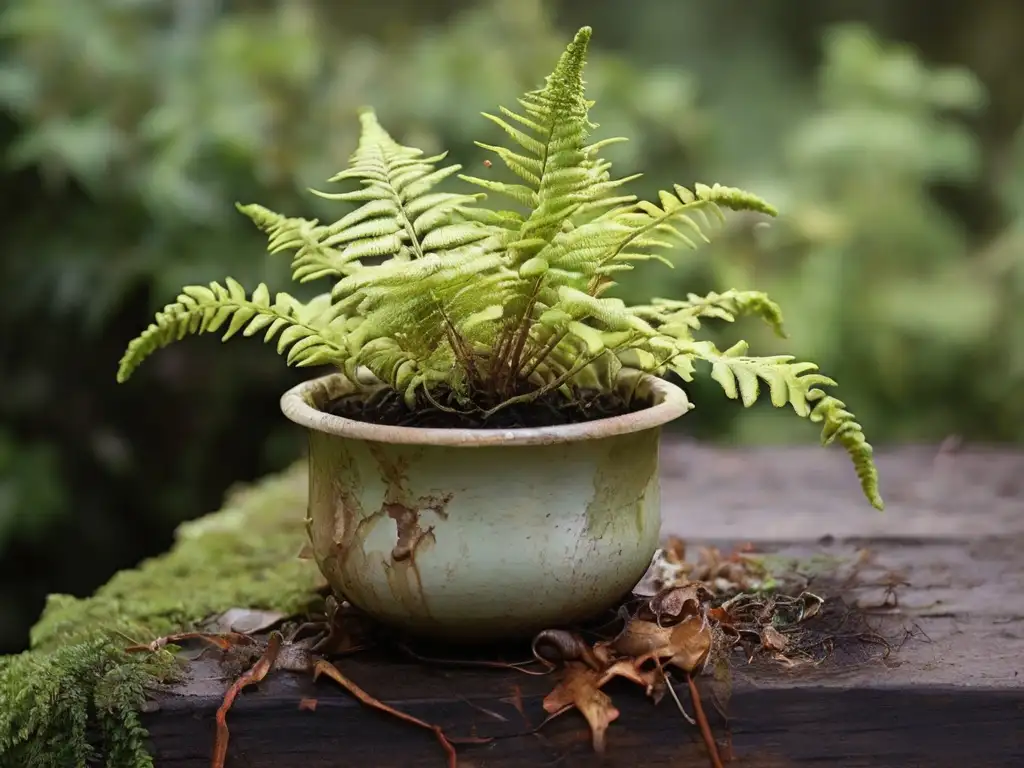Ever found yourself staring at your once lush, green fern now turned brown and crispy, wondering where it all went wrong? Yeah, me too. It’s like a bad break-up with Mother Nature herself. But don’t fret! There’s hope yet! In this guide on How to Revive a Dying Fern we’ll walk you through the steps to bring your plant buddy back from the brink.
So, grab your watering can and put on that green thumb. It’s time to play plant doctor and breathe new life into our leafy friends. Keep reading about ‘How to Revive a Dying Fern’. Trust me, by the end of this, you’ll be running a fern ICU from your living room!
Key Takeaways
- Understanding Ferns: Recognize that ferns are sensitive plants that require specific conditions to thrive. They’re not your average houseplant, so don’t treat them like one!
- Indoor Fern Care: Keep in mind that indoor ferns often turn brown and dry out due to lack of humidity. Consider using a humidifier or misting the leaves regularly.
- Reviving Crispy Fern Leaves: Remember, crispy leaves can be revived by trimming off the dead parts and adjusting watering routines. It’s like giving your fern a fresh haircut and a spa day!
- Yellow and Drooping Leaves: Beware, yellow and drooping leaves usually indicate overwatering. Be careful not to drown your green friend.
- Managing Leaf Loss: Don’t panic if your fern starts losing leaves. It’s often just shedding old growth to make way for new fronds.
- Outdoor Fern Care: Understand that outdoor ferns may struggle with extreme weather conditions. Provide shade during scorching summer days and insulation during frosty winters.
- Light Green Leaves Problem: Note, light green leaves might suggest nutrient deficiency. Time to whip up some plant food!
Remember, reviving a dying fern is all about understanding its needs and adjusting care accordingly. But hey, no pressure! Just imagine you’re a plant whisperer…or something like that!

Fern Turning Brown, Drying Out and Dying
So your indoor fern is looking a bit under the weather, eh? Leaves turning brown, shriveling up, and giving you that “help me” look. Well don’t fret! We’re here to help you figure out how to revive a dying fern.
First things first, let’s talk about why this might be happening. It could be due to a number of reasons like improper indoor fern care, overwatering or under-watering, or even fungal infections. Yeah, ferns can get sick too!
| Problem | Cause | Solution |
|---|---|---|
| Brown Leaves | Overwatering | Adjust watering schedule to allow soil to dry |
| Low Humidity | Increase humidity with a humidifier or misting | |
| Yellow Leaves | Underwatering | Water more frequently, ensuring even moisture |
| Nutrient Deficiency | Apply a balanced, liquid fertilizer monthly | |
| Leaf Loss | Too Much Direct Sunlight | Move fern to a shadier spot |
| Cold Drafts | Relocate fern away from drafty windows or doors | |
| Wilting | Overwatering or Underwatering | Check soil moisture and adjust watering accordingly |
| Slow Growth | Poor Soil Quality | Repot with a rich, organic potting mix |
| Lack of Light | Place in brighter, indirect light | |
| Pest Infestation | Spider Mites, Mealybugs | Use insecticidal soap or neem oil spray |
If your fern leaves are turning brown, it could be because they’re getting too much water or not enough. Overwatering can lead to root rot while under-watering can cause dehydration. Look out for overwatering symptoms in ferns like yellow leaves and wilting or under-watering signs in ferns like dry soil and drooping fronds.
Fungal infections are another common culprit when it comes to browning leaves. If you notice spots on the leaves along with browning, it’s time for some fungus-fighting action!
Now that we know what’s causing the problem, let’s move on to treatments. For overwatered ferns, reduce watering frequency and ensure proper drainage. Under-watered ones need more frequent watering but remember not to drown them! For fungal issues, remove affected leaves and apply a fungicide.
Remember that these green beauties love humidity so maintaining proper humidity for indoor ferns is crucial. They also need just the right amount of sunlight – not too much, not too little.
Lastly, if you’ve recently repotted your fern and it started acting up afterwards, it might be suffering from repotting stress. Give it some time to adjust in its new home before jumping into any drastic measures.
How to Revive Brown, Drying Out, Crispy Fern Leaves
The first thing you need to do in reviving dried ferns is to check the soil. If it’s dry and crumbly, then bingo! You’ve found the culprit. Start by hydrating dry ferns slowly. A little water every day until the soil feels moist but not soggy.
Now, if the soil is wet and your fern still has crispy fern leaves, you might be dealing with an overwatered plant. The symptoms can be confusingly similar to those of underwatering. So how do you tell them apart? Well, if the leaves are yellowing and falling off along with getting crispy, you’re likely overdoing it on the H2O.
To treat an overwatered fern, let it dry out before watering again. And remember – less is more when it comes to watering these delicate plants!
Another important aspect of brown fern care tips involves humidity levels. Ferns love humidity! Consider placing your plant in a bathroom or kitchen where there’s plenty of moisture in the air.
Lastly, don’t forget about light! Too much direct sunlight can scorch those lovely green leaves while too little will leave them starved for energy.



Fern Turning Yellow and Drooping


Oh no, your fern is turning yellow and drooping? Don’t fret, it’s not a death sentence! This could be due to a few reasons like improper watering, lack of nutrients, or pest infestations. Let’s dive into each reason to help you figure out how to revive a dying fern.
First up, let’s talk about water – too much or too little can cause your fern to throw a fit. Overwatering can lead to yellowing fern leaves while underwatering might result in droopy fronds. Look out for overwatering signs in ferns like soggy soil and wilting despite the wet conditions. On the flip side, if the soil feels dry and the leaves are crispy, you’re probably underwatering.
Next on our list is nutrient deficiency. If your fern is looking more pale than vibrant green, it might be screaming for some food! Lack of nutrients can lead to yellow leaves and stunted growth. So remember folks, feed your ferns!
Lastly but definitely not leastly (is that even a word?), pests! These tiny critters love munching on your beloved plants causing them to turn yellow and droop. Keep an eye out for any unusual spots or insects on your plant.
Now that we’ve identified the possible culprits, let’s look at some solutions. For watering issues, adjust accordingly – less water if overwatered and more if underwatered. Nutrient deficiencies can be sorted with regular feeding using a balanced fertilizer. And for pests? A good old insecticidal soap should do the trick!
Remember these fern care tips will go a long way in preventing yellow leaves in ferns and reviving droopy ones! Improving fern health isn’t rocket science after all; it just needs some TLC (Tender Loving Care).
How to Revive Dying Indoor Ferns with Drooping, Yellow Leaves
Drooping leaves and a yellowish tinge are like the plant version of a bad hair day. It’s usually a cry for help, signaling that something in its environment isn’t quite right. But don’t worry, we’ve got some indoor fern care tips that’ll have your green buddy bouncing back in no time.
First off, let’s talk water. Ferns love moisture but hate being waterlogged. If you’re guilty of overwatering, it could be causing those droopy leaves. The trick is to keep the soil damp but never soggy. So if you’ve been treating your fern like a fish, it’s time to dial back on the H2O and start correcting overwatered ferns.
Next up: light and air circulation. Despite what many think, most indoor ferns aren’t fans of direct sunlight. They prefer indirect light and plenty of shade. Too much sun can cause leaf burn and lead to those dreaded yellow leaves – yikes! So remember: when it comes to sunlight requirements for indoor ferns, less is more.
Air circulation is another biggie. Stagnant air can lead to disease and pest problems (no thanks!). To improve air circulation for houseplants, try placing your fern near an open window or using a small fan.
Lastly, let’s touch on humidity and soil conditions. Ferns are tropical plants which means they love high humidity levels (optimal humidity for ferns). A humidifier or regular misting can help keep them happy. And as for soil? Well-drained soil rich in organic matter is what you need for best soil for healthy ferns.
Remember these tips next time you spot signs of distressed ferns and you’ll know exactly how to revive a dying fern. You’ve got this, plant parent!
Why is my Indoor Fern Losing Leaves?


Well, there could be a multitude of reasons why your indoor fern is losing its leaves. Let’s dive into some of the most common culprits.
Firstly, indoor fern care can be tricky. These plants are notorious for being a bit finicky when it comes to their environment. If you’ve noticed leaf drop in ferns, it might be due to improper watering. Both overwatering symptoms and underwatering signs can lead to leaf loss. Overwatering can cause root rot, while underwatering can leave your fern parched and stressed.
Next up, we have pests. Yes, even your indoor plants aren’t safe from these tiny invaders! Fern pests identification is crucial here. Look out for small bugs or unusual spots on the leaves – these could be signs of an infestation.
Another factor to consider is light. While ferns don’t require direct sunlight, they do need a certain amount of indirect light to thrive. Understanding the light requirements for ferns will help you find the perfect spot in your home for your green friend.
Humidity levels also play a significant role in indoor plant health. Ferns love high humidity, so if your home’s air is too dry, this could cause leaf loss. Regular misting or using a humidifier can help maintain optimal humidity levels for indoor plants.
Nutrient deficiencies or an excess of certain nutrients can also lead to leaf loss in ferns. If you suspect this might be the case, consider getting a soil test kit to identify any potential nutrient deficiencies in ferns.
Lastly, both repotting and temperature stress can cause leaf drop in houseplants like ferns. Be mindful when changing pots (repotting stress in plants) and keep an eye on drastic temperature changes (temperature stress in houseplants).
Remember, figuring out how to revive a dying fern is all about identifying the problem and then taking the right steps to fix it. So don’t lose hope, your fern can bounce back with a little TLC!
How to Revive a Fern Losing Leaves


Ever wondered why your fern is shedding leaves like a dog in summer? Well, it’s not because it’s trying to go bald. Fern leaf loss causes can range from underwatering to overwatering, improper lighting, or even those pesky pests.
First things first, let’s talk about water – the lifeblood of any plant. If your fern is looking more like a dried-up tumbleweed than a lush green paradise, underwatering symptoms in ferns might be the culprit. These plants love their H2O! So, don’t be shy with the watering can but remember, too much love (read: water) can also be harmful. Overwatering signs in ferns include yellowing leaves and root rot. It’s all about striking that perfect balance!
Next up on our list of suspects is lighting. Ferns are like Goldilocks – they need their light just right! Not too bright, not too dark – optimal lighting for indoor ferns is indirect sunlight. So no sunbathing for these babies!
Now let’s talk about uninvited guests – pests! Aphids, mealybugs, and scale insects are some common pests affecting ferns. But don’t worry; you won’t need an exterminator for this job. There are plenty of natural pest remedies for plants, like neem oil or insecticidal soap.
Last but not least, consider humidity and seasonal changes when caring for your ferns. They thrive in humid environments and may require extra attention during drier seasons or when indoor heating is used extensively.
So there you have it folks! Some handy-dandy fern care tips to help you master the art of reviving dying ferns. Remember – patience is key when learning how to revive a dying fern!
Why is My Fern Dying Outside?


Alright, let’s get down to the nitty-gritty of why your fern might be waving a white flag. There are several reasons why your fern could be on its last fronds, and we’re going to tackle them one by one.
First up, outdoor fern care can be tricky because these plants are sensitive to sunlight exposure. Too much sun can lead to sunburn in ferns, causing their leaves to turn yellow or brown. On the flip side, too little light can stunt their growth.
Next on our list is watering practices. Both overwatering and under-watering can spell disaster for your green buddy. Overwatering signs in ferns include yellowing leaves and root rot, while under-watering effects on ferns often result in dry, wilted fronds.
Soil conditions are another biggie when it comes to keeping your fern healthy. Optimal soil conditions for ferns involve well-draining soil that’s rich in organic matter. If the soil is too heavy or compacted, it can lead to waterlogging and root rot.
Now let’s talk about pests and diseases – every plant owner’s worst nightmare! Common culprits include aphids, mealybugs, and scale insects (common pests on outdoor ferns). Plus, fungal diseases like leaf spot and root rot can wreak havoc on your plant (fungal infections in ferns treatment).
Last but not least, don’t forget about seasonal changes! Ferns need different care during different times of the year (seasonal care tips for outdoor ferns). So remember – understanding how to properly care for your plant throughout the year is key when learning how to revive a dying fern.
And there you have it – a quick rundown of what might be causing trouble for your beloved outdoor fern. But don’t worry, we’ll be diving into how to fix these issues in the next section. So stay tuned!
How to Revive a Dying Outdoor Fern
First off, overwatering or underwatering can turn your fern into a sad, wilted mess. If you’ve been showering it with too much love (read: water), you’ll need an overwatered fern treatment pronto. Ease up on the watering and let the soil dry out between drinks. On the flip side, if your fern’s leaves are crispy and brown, it’s probably parched. Look for underwatered fern signs like drooping fronds and give it a good soak.
Next up on our list of suspects are pests. These little buggers can wreak havoc on your plant’s health. Regular fern pest control is essential to keep them at bay. Try using an organic insecticide or even a homemade soap solution.
Fungal infections in ferns are another common culprit behind a dying plant. If you spot any fuzzy white spots or blackened leaves, it’s time to act fast! Remove the affected parts and treat with an appropriate fungicide.
Lastly, don’t forget about sunlight and nutrients! Ferns love indirect light but can get sunburnt if exposed directly for too long. Adjust its sunlight exposure for ferns accordingly. Also check for nutrient deficiencies in ferns, which can cause yellowing leaves or slow growth.
Why is My Fern Turning Light Green?
Well, fern-friends, if your leafy buddy is turning a lighter shade of green, it might be trying to tell you something. Just like us humans, ferns can get a bit under the weather too. Fern care tips often mention that light green leaves are usually a cry for help from your plant.
One common culprit could be a nutrient deficiency in ferns. Your fern might be lacking some essential nutrients like nitrogen or iron, which can lead to those light green leaves. To fix this, try adding some good-quality plant food to your watering routine.
Another possible cause could be improper lighting. Ferns are not sun worshipers and prefer indirect light. So if your fern’s been catching too many rays or hiding in the shadows, it could start looking a bit pale. Adjusting your proper fern lighting conditions should bring back that vibrant green color.
Watering issues can also turn your fern into an unhappy camper. Both overwatering and under-watering can lead to light green leaves – talk about being finicky! Look out for overwatering symptoms like yellowing leaves or under-watering signs such as dry soil and wilting fronds.
Humidity is another key factor in our indoor fern care guide. These plants love moisture! If the air around your fern is too dry, it may start fading away. Maintaining the optimal humidity for ferns will keep them happy and healthy.
In short, diagnosing why your fern is turning light green involves playing detective and understanding its needs better. But don’t worry – with these tips on how to revive a dying fern, you’ll have your plant back to its lush self in no time!
Frequently Asked Questions
Can I use coffee grounds as fertilizer for my ferns?
Absolutely, but moderation is key! Coffee grounds can add nitrogen to the soil, which ferns love. Just sprinkle them lightly around the plant, avoiding direct contact with leaves to prevent mold.
How often should I repot my fern?
Ferns generally enjoy being a bit root-bound, but if you notice roots poking out of the pot’s drainage holes or growth has significantly slowed, it’s time for a bigger home. This usually happens every 2-3 years.
Is tap water okay for watering my ferns, or should I use distilled water?
While most ferns can tolerate tap water, they truly thrive on rainwater or distilled water due to the absence of chlorine and fluoride. If tap is your only option, let it sit out overnight to allow some chemicals to evaporate.
What are the signs of overwatering in ferns?
Look out for yellowing leaves and a general droopy appearance. Also, if the soil feels soggy or smells musty, you might be loving your fern a little too much with water.
Can ferns recover from frost damage?
Yes, they can bounce back with proper care. Trim any damaged fronds and move the plant to a warmer spot. Keep the soil slightly moist and wait patiently; recovery might take some time.
Why does my indoor fern have pests and how do I deal with them?
Pests like spider mites and mealybugs adore the humid conditions ferns thrive in. Isolate affected plants immediately and treat with insecticidal soap or neem oil. Regular misting can deter future infestations.
How do I increase humidity for my indoor ferns?
Grouping plants together creates a mini-humidity climate. Alternatively, place your fern on a tray filled with pebbles and water or invest in a humidifier for more consistent moisture in the air.


To Wrap Up
So, we’ve journeyed through the jungle of How to Revive a Dying Fern. Like a plant doctor, you now know how to diagnose and treat your fern’s woes.
Remember, your fern is like a moody artist—it needs just the right environment and care. So go on, give it some TLC and watch it thrive!


